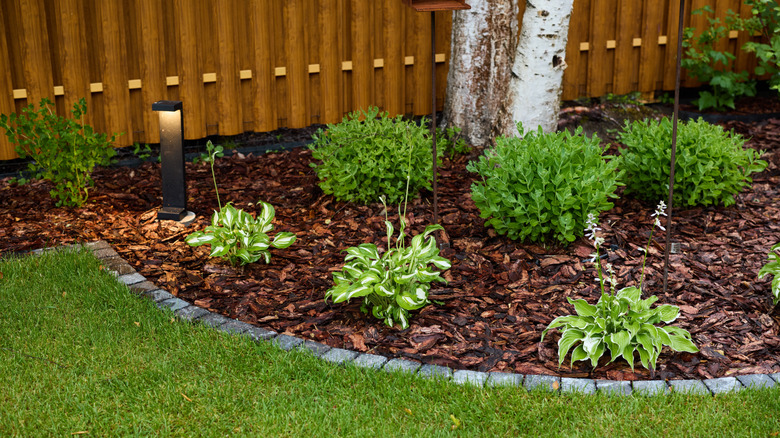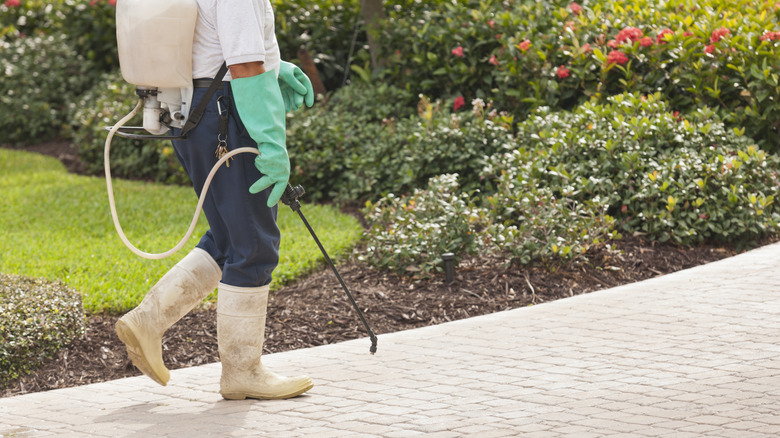Tips And Tricks To Prevent Weeds From Growing Close To Your Fence
We may receive a commission on purchases made from links.
Fences serve a range of purposes, from security and privacy to noise reduction and aesthetics. When you install a fence, you likely consider details such as the material, height, and color. What you might not think about is preemptively preventing weed growth with options including physical barriers and herbicide products. It might not be one of the biggest mistakes everyone makes when installing a fence, but failing to plan for weed prevention could cause more work than necessary. Plus, a weedy yard leaves your fence looking worn and unattractive.
While some types of physical barriers do work to prevent weeds, the fence structure itself doesn't. Those persistent unwanted plants often find a way to flourish along all kinds of fences. Chain link fences can be particularly bad for weed growth because they don't block the sunlight. Using various weed prevention methods discourages the plants from growing and makes less work for you.
Preventing weeds also protects your fence from damage. Larger weeds could crack or shift your fence with their deep roots and stems. Vegetation pressed against a wooden fence could cause damage by holding moisture against the material. What's more, weeds in your yard could actually attract pests. Some pests, in particular, including termites and carpenter ants, could destroy a wood fence.
Incorporate physical barriers
Instead of defaulting to weed removal hacks, take a proactive approach to prevent weeds along your fence line by creating physical barriers that make it difficult for weeds to grow. Digging a shallow trench along the fence creates a clean edge where you can more easily watch for weed growth. A hardscape barrier made of bricks or pavers is another option — dig a wider trench to accommodate the selected material. These options create a buffer around your fence to keep grass and weeds away from the structure.
If you want to incorporate a landscaped area along your fence, mulching the beds helps to suppress weeds in the area. You typically need about 2 to 3 inches of mulch to stop weeds from germinating. The thick layer of material blocks sunlight from reaching weed seeds, prohibiting growth. You can also put mulch around the base of various plants near the fence, including flowers and shrubs, to create a polished look. If you use organic mulch, such as wood-based mulch, you'll need to replenish it periodically as it breaks down and decomposes.
You might also find weeds growing in your gravel or around your other hardscape surfaces if you don't properly prepare the sites. Using landscape fabric as the foundation for any of these hardscape barrier options helps by initially preventing weeds from germinating for at least a couple of years. The fabric is easy to cut to size and lay in place after you dig your trench or landscape area.
Choose the right herbicides
Herbicides, as weed deterrents, employ various chemicals and methods to kill plants at different stages. Some types are used to kill weeds after they emerge. However, when you're aiming to prevent weed growth along your fence, pre-emergent herbicides are the preferred formula to stop germination before the weeds can grow. Herbicides can be selective, meaning they only target specific types of plants, or non-selective, meaning they kill any plants in the area. If you have landscaping along the fence, a non-selective herbicide could harm the vegetation. Knowing what type of weeds you have in your yard, particularly along your fence, can help you choose a pre-emergent herbicide that matches that plant type.
If you're looking for one of the least harmful ways to kill weeds and keep them under control, natural herbicide options may work. Vinegar works well for killing plants on contact, but it won't prevent new weed growth and only kills the plant above the ground, not the roots. When you want to focus on prevention, look for organic weed control products, such as granular herbicides, similar to Espoma Organic Weed Preventer, formulated to stop weeds from growing. No matter what herbicide you use, read the package warnings and instructions carefully to apply the product correctly.


